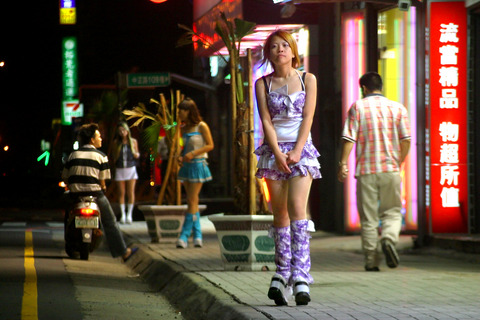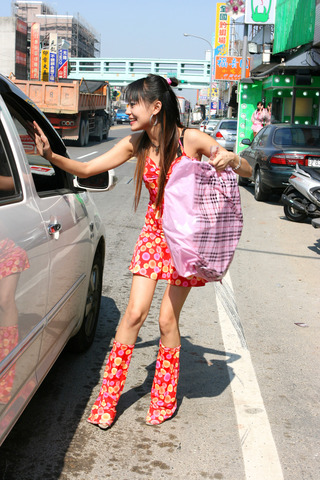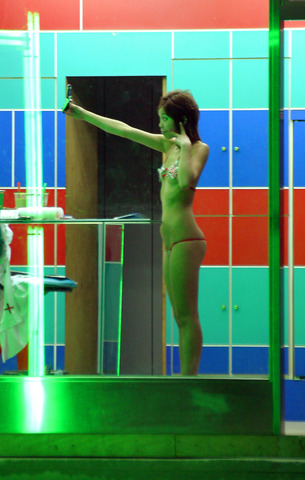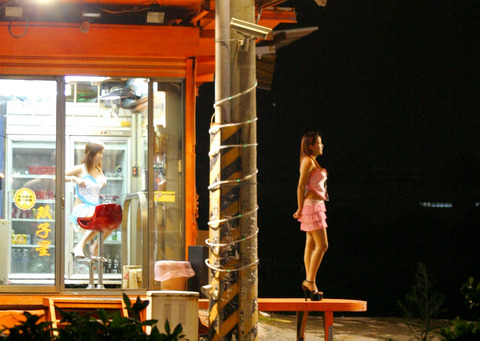Anyone who has traveled outside Taipei City will have noticed betel-nut beauties (檳榔西施) brightening the roadsides. Like brightly-plumed birds they flit in and out of their neon-framed stalls to serve drinks, cigarettes and the addictive nut that keeps truck drivers awake as they careen down the country's highways.
A couple of years ago a club promoter left the capital city in a convoy of three cars for a party in Kaohsiung. The goal was to stop at every betel-nut stand on the way and take pictures of the girls. It took them two days but at the end of a drunken journey they had assembled a selection of portraits for their PowerPoint presentations that ranged from "really stunning model look-alikes to skinny crack-ho messes with just two teeth."
South African documentary maker Tobie Openshaw took a different route and has compressed seven years of interviewing, filming and photographing betel-nut girls for a sensitive and decorous exhibition of 30 prints, which opened last weekend at the Hung Chong Gallery (恆昶藝廊) in Taipei.

PHOTOS COURTESY OF TOBIE OPENSHAW
Betel-Nut Beauty: Exploring the Art, the Beauty and Heart aims to shine new light on the subject. The oft-held thesis is betel-nut girls are young and abused. The truth is they are adults who make a reasonably well-paid choice to sell the nuts, Openshaw said.
Another thesis is betel-nut beauties are low class because they expose their bodies. As a result the occasional legislator will charge betel-nut girls with destroying the moral fabric of the nation. This is why the beauties are banned from Taipei City and told to cover up elsewhere. The truth, according to Openshaw, is singers and actresses like Jolin Tsai (蔡依林) also show off their bodies but they are looked up to for it.
"The reasons quoted for fighting this phenomenon are always wrong, always about the morals of Taiwan rather than the health of its people. I don't understand what the fuss over scantily clad women is about. The real problem is the bad effects of betel nuts, which should carry health warnings," Openshaw said, adding he had never tried one because they are cancerous, habit forming and look disgusting.

Instead, Openshaw buys coffee and cigarettes from the roadside parlors near his home in Taoyuan City before starting work in the morning at a software company. "It's a pick-me-up. I get a nice smile and that's how I got to know the girls," he said on a tour last week of his city's betel-nut hotspots.
Along with his production manager, Joy Hsieh, who interviews the women while Openshaw films or shoots, we were introduced to a number of betel-nut beauties. Petite and tattooed Hsiao Juan (小娟) wobbled around on white platform shoes as she served and talked. "I'm proud of the exhibition, it will help people get to know us,” she said.
The more conservatively dressed Hsuan Hsuan (瑄瑄), 24, is from Vietnam and came here to marry a taxi driver, with whom she has two children. She runs the betel-nut stall on her own and said business was good but she wanted to do something else.

Hsiao Ching (小晴) has the cute doll look and is in her early 20s. She said the work was not too demanding and she earned about NT$30,000 a month. Customers irritated her sometimes, she said, because they interrupted her when she was talking on the phone and Japanese tourists sometimes hung around gawping. She pointed out the TV surveillance cameras and a stun gun when we asked about security. Her problem, she said, was meeting “nice guys” who could accept her job.
Openshaw said most of the girls he interviewed were happy with their lot and others worked for a short time and moved on. He countered rumors of prostitution by saying he had heard of cases but didn't see how it could work practically. “It's just not the same kind of business. This is about selling nuts.”
And sex sells nuts. This much is obvious from a quick tour of the exhibition. A girl in a skimpy pink ensemble and towering heels stares into the camera, arms crossed, leaning against her glass-fronted booth. In the next picture two girls patrol the areas in front of their betel-nut stands. Their attitudes appear to be bashful, playful and come-hither. Outside the same stand, in another image, one girl is seated while another balances on one leg and we can see panties under her skirt.

These kinds of pictures are eye candy, like flicking through a lifestyle magazine and finding the occasional titillating shot. They are not pornographic because they do not “cross the line,” according to Kloie Picot, a Canadian photojournalist and videographer. “These girls offer the illusion of sex.”
There was one picture, however, which she objected to. It was of a young woman dressed in a practically non-existent bikini, taking a picture of herself with a mobile phone. “She's crossed the line, she's feeding herself to the guys and making it so the other girls have to keep up [by wearing less],” Picot said.
Point taken, but it was one of the most interesting shots, more documentary than lifestyle. It offers a different insight into the mind of the betel-nut beauty and the business she is in. Pretty shots of young women framed in mirrors and posing by the roadside in nurse costumes do not reveal any more than we see in a car passing by a betel nut stand.

PHOTO: JULES QUARTLY, TAIPEI TIMES
This is not necessarily a criticism as Openshaw's stated intention is to shine a light on the “art, the beauty and heart” of the business. The exhibition does not look behind the smiles, even if they are fake. As a result the girls look like models or pop singers.
Unlike the club promoter and his convoy of amateur photographers, Openshaw has focused on the aesthetically and morally pleasing facets of the betel nut girl business. “Skinny crack-ho messes with just two teeth” and child brides from Vietnam selling betel nut have no place here.
The Hung Chong Gallery (恆昶藝廊) is at 1F, 396-1 Renai Rd Sec 4, Taipei (台北市仁愛路四段396-1號1樓). It is open daily 10am to 6pm and the exhibition is until March 8.
Also see www.youtube.com/watch?v=HJo7ZkLwkng&mode=related&search=betelnut and www.youtube.com/watch?v=LJWxs6eRNvY&mode=related&search=betelnut

Exceptions to the rule are sometimes revealing. For a brief few years, there was an emerging ideological split between the Democratic Progressive Party (DPP) and Chinese Nationalist Party (KMT) that appeared to be pushing the DPP in a direction that would be considered more liberal, and the KMT more conservative. In the previous column, “The KMT-DPP’s bureaucrat-led developmental state” (Dec. 11, page 12), we examined how Taiwan’s democratic system developed, and how both the two main parties largely accepted a similar consensus on how Taiwan should be run domestically and did not split along the left-right lines more familiar in

This month the government ordered a one-year block of Xiaohongshu (小紅書) or Rednote, a Chinese social media platform with more than 3 million users in Taiwan. The government pointed to widespread fraud activity on the platform, along with cybersecurity failures. Officials said that they had reached out to the company and asked it to change. However, they received no response. The pro-China parties, the Chinese Nationalist Party (KMT) and Taiwan People’s Party (TPP), immediately swung into action, denouncing the ban as an attack on free speech. This “free speech” claim was then echoed by the People’s Republic of China (PRC),

As I finally slid into the warm embrace of the hot, clifftop pool, it was a serene moment of reflection. The sound of the river reflected off the cave walls, the white of our camping lights reflected off the dark, shimmering surface of the water, and I reflected on how fortunate I was to be here. After all, the beautiful walk through narrow canyons that had brought us here had been inaccessible for five years — and will be again soon. The day had started at the Huisun Forest Area (惠蓀林場), at the end of Nantou County Route 80, north and east

Specialty sandwiches loaded with the contents of an entire charcuterie board, overflowing with sauces, creams and all manner of creative add-ons, is perhaps one of the biggest global food trends of this year. From London to New York, lines form down the block for mortadella, burrata, pistachio and more stuffed between slices of fresh sourdough, rye or focaccia. To try the trend in Taipei, Munchies Mafia is for sure the spot — could this be the best sandwich in town? Carlos from Spain and Sergio from Mexico opened this spot just seven months ago. The two met working in the